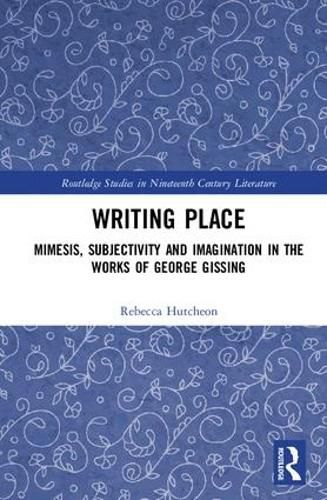Readings Newsletter
Become a Readings Member to make your shopping experience even easier.
Sign in or sign up for free!
You’re not far away from qualifying for FREE standard shipping within Australia
You’ve qualified for FREE standard shipping within Australia
The cart is loading…






Exploring a hitherto neglected field, Writing Place: Mimesis, Subjectivity and Imagination in the Works of George Gissing is the first monograph to consider the works of George Gissing (1857-1903) in light of the ‘spatial turn’. By exploring how objectivity and subjectivity interact in his work, the book asks: what are the risks of looking for the ‘real’ in Gissing’s places? How does the inherent heterogeneity of Gissing’s observation influence the textual recapitulation of place? In addition to examining canonical texts such as The Nether World (1889), New Grub Street (1891), and The Private Papers of Henry Ryecroft (1901), the book analyses the lesser-known novels, short stories, journalism and personal writings of Gissing, in the context of modern spatial studies. The book challenges previously biographical and London-centric accounts of Gissing’s representation of space and place by re-examining seemingly innate contemporaneous geographical demarcations such as the north and the south, the city, suburb, and country, Europe and the world, and re-reading Gissing’s places in the contexts of industrialism, ruralism, the city in literature, and travel writing. Through sustained attention to the ambiguities and contradictions rooted in the form and content of his writing, the book concludes that, ultimately, Gissing’s novels undermine spatial dichotomies by emphasising and celebrating the incongruity of seeming certainties
$9.00 standard shipping within Australia
FREE standard shipping within Australia for orders over $100.00
Express & International shipping calculated at checkout
Exploring a hitherto neglected field, Writing Place: Mimesis, Subjectivity and Imagination in the Works of George Gissing is the first monograph to consider the works of George Gissing (1857-1903) in light of the ‘spatial turn’. By exploring how objectivity and subjectivity interact in his work, the book asks: what are the risks of looking for the ‘real’ in Gissing’s places? How does the inherent heterogeneity of Gissing’s observation influence the textual recapitulation of place? In addition to examining canonical texts such as The Nether World (1889), New Grub Street (1891), and The Private Papers of Henry Ryecroft (1901), the book analyses the lesser-known novels, short stories, journalism and personal writings of Gissing, in the context of modern spatial studies. The book challenges previously biographical and London-centric accounts of Gissing’s representation of space and place by re-examining seemingly innate contemporaneous geographical demarcations such as the north and the south, the city, suburb, and country, Europe and the world, and re-reading Gissing’s places in the contexts of industrialism, ruralism, the city in literature, and travel writing. Through sustained attention to the ambiguities and contradictions rooted in the form and content of his writing, the book concludes that, ultimately, Gissing’s novels undermine spatial dichotomies by emphasising and celebrating the incongruity of seeming certainties